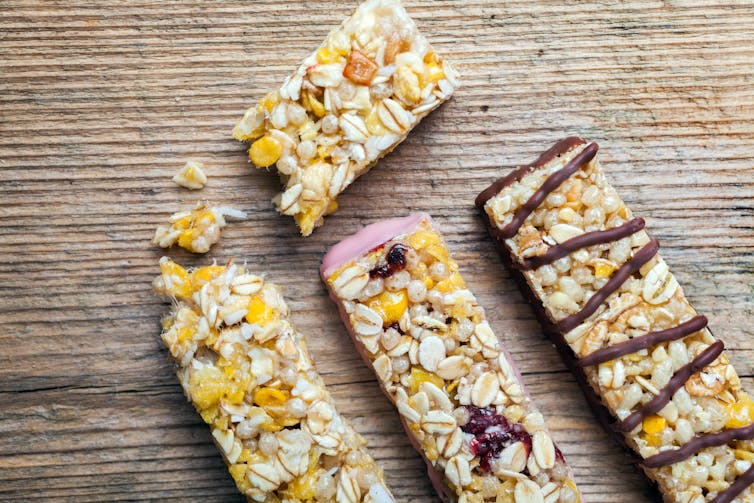November 12, 2018
Five food mistakes to avoid if you're trying to lose weight
Salads are a lot less healthy once you make additions like croutons and a creamy dressing.
Many people wonder why theyâre not losing weight when they follow a strict diet and exercise routine.
One possible reason is that what look like healthy options arenât what they seem. Many foods and drinks contain hidden fats, sugars or salt, each of which will curb your weight loss efforts. In addition to the kilojoules, these flavoursome foods leave you wanting more.
Losing weight is largely about tipping the balance of kilojoules in and out. If youâre trying to lose weight or simply seeking a healthier lifestyle, here are five common traps that might be hindering you.
1. All salads are good for you
Vegetables are good for you, absolutely. But salads often include other ingredients, which will hike up your kilojoule (kJ) count.
A Caesar salad looks green and leafy but is filled with hidden fats from the bacon (40g fat; 360kJ), parmesan cheese (6g fat; 340kJ) and creamy salad dressing lathered over the top (20g fat; 770kJ). Even the croutons are fried for added crunch. So a Caesar salad gives you your total daily fat intake for an average adult in one meal.
On par with this is a creamy pasta salad, often seen at family barbecues. A side serve of this comes in at almost 920 kilojoules.
Fats provide the from food (followed closely by alcohol, but more on that later). So be wary of dressings, sauces, gravies and high fat foods that may be adding kilojoules to your meal.
2. I donât eat junk food, just âhealthyâ snacks
Australians consume more than from discretionary or âjunkâ foods, such as biscuits, chips and chocolate. None of these are providing us with any vital nutrients. These are the kilojoules we need to shift to lose weight.
But many people make the mistake of swapping junk food for seemingly âhealthy snacksâ, such as muesli bars and protein balls. While these can claim to be healthy and organic, theyâre often processed and high in kilojoules.

Muesli bars do contain healthy ingredients such as oats, nuts and seeds. But sticking all the parts together to form a bar is usually achieved with a form of sugar. A yoghurt, fruit and nut bar can contain of sugar.
Next time you feel like a snack, why not with a handful of nuts and seeds. This will provide you with useful vitamins and minerals â minus the sugar sticking them together.
3. Natural sweeteners are better than sugar
Thereâs recently been a shift towards more natural forms of added sugar, but they contain no additional nutrients and no fewer kilojoules. Adding honey or agave syrup to your dish does not differ nutritionally from adding sugar to the same dish. It may taste different, but youâre still adding sugar.
Next time you feel like something sweet, try adding some fruit instead. It has a natural sweetness and will give you extra vitamins and minerals.
If you find your downfall is adding sugar to coffee, try using soy milk instead of cowâs milk. It has a sweeter taste (but one that may need some getting used to in the first instance).
Or try reducing the amount of sugar you add by half a teaspoon each week. Youâll find you barely notice the difference after a while.
4. Anything fruit-based must be healthy
Think of the humble banana, mashed up into banana bread. This is not a bread at all, but a cake. If youâve ever made banana bread youâll realise just how much butter and extra sugar gets added to something nature has already made to be sweet and in its own convenient package.
Meanwhile, fruit drinks generally contain only 25% fruit juice and are very high in sugar. But even when drinking 100% fruit juice, youâre missing out on the important fibre that comes naturally from fruit and helps your body recognise it feels full. So whole fruit is best.
Fruit smoothies, although slightly better than fruit juices, are another one you can easily be caught out on. Smoothies are generally prepared in large servings and may have syrups or ice creams added to them, reducing their nutritional value by comparison.

5. Drinks canât have too many kilojoules⊠right?
If youâre trying to lose weight, youâll know sugary soft drinks are a no-go. But some of the easiest mistakes to make are those in liquid form.
Many people arenât aware how many kilojoules are in . An average restaurant serving of red wine is equivalent to 1.5 and contains 480 kilojoules.
So after two glasses of wine, not only have you exceeded the recommended two standard drinks, but youâve also consumed the equivalent kilojoules to eating two full cups of corn chips. The same applies for beer, where just one schooner equates to 1.6 standard drinks which is the same as 615 kilojoules.
Of course, many of us donât stop at one.
A final word
Probably the most common food mistake when trying to lose weight is eating too much. We need to choose the right foods but the amount is also important.
We need to listen to the signals our bodies send when when weâre getting full to stop eating. The best way to do this is to eat slowly, chewing carefully. By slowing our eating we are more likely to be sent the sign of fullness before feeling it at our waistband.![]()
, Senior lecturer, School of Medicine, and , PhD Candidate,
This article is republished from under a Creative Commons license. Read the .
UOW academics exercise academic freedom by providing expert commentary, opinion and analysis on a range of ongoing social issues and current affairs. This expert commentary reflects the views of those individual academics and does not necessarily reflect the views or policy positions of the ÁńÁ«ÊÓÆ”app of ÁńÁ«ÊÓÆ”app.
:format(jpg)/prod01/channel_3/assets/live-migration/www/images/content/groups/public/web/media/documents/mm/uow253225.jpg)